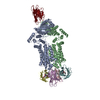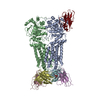+ Open data
Open data
- Basic information
Basic information
| Entry | Database: PDB / ID: 8p7w | ||||||
|---|---|---|---|---|---|---|---|
| Title | Structure of 5D3-Fab and nanobody(Nb8)-bound ABCG2 | ||||||
 Components Components |
| ||||||
 Keywords Keywords | MEMBRANE PROTEIN | ||||||
| Function / homology |  Function and homology information Function and homology informationbiotin transmembrane transporter activity / biotin transport / riboflavin transport / riboflavin transmembrane transporter activity / sphingolipid transporter activity / renal urate salt excretion / Abacavir transmembrane transport / urate metabolic process / sphingolipid biosynthetic process / urate transmembrane transporter activity ...biotin transmembrane transporter activity / biotin transport / riboflavin transport / riboflavin transmembrane transporter activity / sphingolipid transporter activity / renal urate salt excretion / Abacavir transmembrane transport / urate metabolic process / sphingolipid biosynthetic process / urate transmembrane transporter activity / Sphingolipid de novo biosynthesis / external side of apical plasma membrane / xenobiotic transport across blood-brain barrier / organic anion transport / : / transepithelial transport / Ciprofloxacin ADME / export across plasma membrane / Paracetamol ADME / NFE2L2 regulating MDR associated enzymes / Differentiation of Keratinocytes in Interfollicular Epidermis in Mammalian Skin / ABC-type xenobiotic transporter / Heme biosynthesis / cellular detoxification / ABC-type xenobiotic transporter activity / Heme degradation / efflux transmembrane transporter activity / ATPase-coupled transmembrane transporter activity / xenobiotic transmembrane transporter activity / transport across blood-brain barrier / brush border membrane / Iron uptake and transport / transmembrane transport / mitochondrial membrane / apical plasma membrane / membrane raft / protein homodimerization activity / ATP hydrolysis activity / nucleoplasm / ATP binding / identical protein binding / plasma membrane Similarity search - Function | ||||||
| Biological species |  Homo sapiens (human) Homo sapiens (human)  | ||||||
| Method | ELECTRON MICROSCOPY / single particle reconstruction / cryo EM / Resolution: 3.04 Å | ||||||
 Authors Authors | Irobalieva, R.N. / Manolaridis, I. / Jackson, S.M. / Ni, D. / Pardon, E. / Stahlberg, H. / Steyaert, J. / Locher, K.P. | ||||||
| Funding support |  Switzerland, 1items Switzerland, 1items
| ||||||
 Citation Citation |  Journal: J Mol Biol / Year: 2023 Journal: J Mol Biol / Year: 2023Title: Structural Basis of the Allosteric Inhibition of Human ABCG2 by Nanobodies. Authors: Rossitza N Irobalieva / Ioannis Manolaridis / Scott M Jackson / Dongchun Ni / Els Pardon / Henning Stahlberg / Jan Steyaert / Kaspar P Locher /   Abstract: ABCG2 is an ATP-binding cassette transporter that exports a wide range of xenobiotic compounds and has been recognized as a contributing factor for multidrug resistance in cancer cells. Substrate and ...ABCG2 is an ATP-binding cassette transporter that exports a wide range of xenobiotic compounds and has been recognized as a contributing factor for multidrug resistance in cancer cells. Substrate and inhibitor interactions with ABCG2 have been extensively studied and small molecule inhibitors have been developed that prevent the export of anticancer drugs from tumor cells. Here, we explore the potential for inhibitors that target sites other than the substrate binding pocket of ABCG2. We developed novel nanobodies against ABCG2 and used functional analyses to select three inhibitory nanobodies (Nb8, Nb17 and Nb96) for structural studies by single particle cryo-electron microscopy. Our results showed that these nanobodies allosterically bind to different regions of the nucleotide binding domains. Two copies of Nb8 bind to the apex of the NBDs preventing them from fully closing. Nb17 binds near the two-fold axis of the transporter and interacts with both NBDs. Nb96 binds to the side of the NBD and immobilizes a region connected to key motifs involved in ATP binding and hydrolysis. All three nanobodies prevent the transporter from undergoing conformational changes required for substrate transport. These findings advance our understanding of the molecular basis of modulation of ABCG2 by external binders, which may contribute to the development of a new generation of inhibitors. Furthermore, this is the first example of modulation of human multidrug resistance transporters by nanobodies. | ||||||
| History |
|
- Structure visualization
Structure visualization
| Structure viewer | Molecule:  Molmil Molmil Jmol/JSmol Jmol/JSmol |
|---|
- Downloads & links
Downloads & links
- Download
Download
| PDBx/mmCIF format |  8p7w.cif.gz 8p7w.cif.gz | 363.7 KB | Display |  PDBx/mmCIF format PDBx/mmCIF format |
|---|---|---|---|---|
| PDB format |  pdb8p7w.ent.gz pdb8p7w.ent.gz | 292.9 KB | Display |  PDB format PDB format |
| PDBx/mmJSON format |  8p7w.json.gz 8p7w.json.gz | Tree view |  PDBx/mmJSON format PDBx/mmJSON format | |
| Others |  Other downloads Other downloads |
-Validation report
| Summary document |  8p7w_validation.pdf.gz 8p7w_validation.pdf.gz | 1.1 MB | Display |  wwPDB validaton report wwPDB validaton report |
|---|---|---|---|---|
| Full document |  8p7w_full_validation.pdf.gz 8p7w_full_validation.pdf.gz | 1.1 MB | Display | |
| Data in XML |  8p7w_validation.xml.gz 8p7w_validation.xml.gz | 66.2 KB | Display | |
| Data in CIF |  8p7w_validation.cif.gz 8p7w_validation.cif.gz | 99 KB | Display | |
| Arichive directory |  https://data.pdbj.org/pub/pdb/validation_reports/p7/8p7w https://data.pdbj.org/pub/pdb/validation_reports/p7/8p7w ftp://data.pdbj.org/pub/pdb/validation_reports/p7/8p7w ftp://data.pdbj.org/pub/pdb/validation_reports/p7/8p7w | HTTPS FTP |
-Related structure data
| Related structure data |  17537MC  8p8aC  8p8jC M: map data used to model this data C: citing same article ( |
|---|---|
| Similar structure data | Similarity search - Function & homology  F&H Search F&H Search |
- Links
Links
- Assembly
Assembly
| Deposited unit | 
|
|---|---|
| 1 |
|
- Components
Components
| #1: Protein | Mass: 72385.852 Da / Num. of mol.: 2 Source method: isolated from a genetically manipulated source Source: (gene. exp.)  Homo sapiens (human) / Gene: ABCG2, ABCP, BCRP, BCRP1, MXR / Production host: Homo sapiens (human) / Gene: ABCG2, ABCP, BCRP, BCRP1, MXR / Production host:  Homo sapiens (human) Homo sapiens (human)References: UniProt: Q9UNQ0, ABC-type xenobiotic transporter #2: Antibody | Mass: 13481.859 Da / Num. of mol.: 2 Source method: isolated from a genetically manipulated source Source: (gene. exp.)   #3: Antibody | Mass: 23843.633 Da / Num. of mol.: 2 Source method: isolated from a genetically manipulated source Source: (gene. exp.)   #4: Antibody | Mass: 23594.016 Da / Num. of mol.: 2 Source method: isolated from a genetically manipulated source Source: (gene. exp.)   Has protein modification | Y | |
|---|
-Experimental details
-Experiment
| Experiment | Method: ELECTRON MICROSCOPY |
|---|---|
| EM experiment | Aggregation state: PARTICLE / 3D reconstruction method: single particle reconstruction |
- Sample preparation
Sample preparation
| Component |
| ||||||||||||||||||||||||||||||
|---|---|---|---|---|---|---|---|---|---|---|---|---|---|---|---|---|---|---|---|---|---|---|---|---|---|---|---|---|---|---|---|
| Source (natural) |
| ||||||||||||||||||||||||||||||
| Source (recombinant) |
| ||||||||||||||||||||||||||||||
| Buffer solution | pH: 7.5 | ||||||||||||||||||||||||||||||
| Specimen | Conc.: 1 mg/ml / Embedding applied: NO / Shadowing applied: NO / Staining applied: NO / Vitrification applied: YES | ||||||||||||||||||||||||||||||
| Specimen support | Grid material: COPPER / Grid mesh size: 300 divisions/in. / Grid type: Quantifoil R1.2/1.3 | ||||||||||||||||||||||||||||||
| Vitrification | Cryogen name: ETHANE-PROPANE |
- Electron microscopy imaging
Electron microscopy imaging
| Experimental equipment |  Model: Titan Krios / Image courtesy: FEI Company |
|---|---|
| Microscopy | Model: TFS KRIOS |
| Electron gun | Electron source:  FIELD EMISSION GUN / Accelerating voltage: 300 kV / Illumination mode: FLOOD BEAM FIELD EMISSION GUN / Accelerating voltage: 300 kV / Illumination mode: FLOOD BEAM |
| Electron lens | Mode: BRIGHT FIELD / Nominal defocus max: 2400 nm / Nominal defocus min: 600 nm |
| Specimen holder | Cryogen: NITROGEN |
| Image recording | Electron dose: 72 e/Å2 / Film or detector model: GATAN K2 SUMMIT (4k x 4k) |
- Processing
Processing
| EM software |
| ||||||||||||||||||||||||
|---|---|---|---|---|---|---|---|---|---|---|---|---|---|---|---|---|---|---|---|---|---|---|---|---|---|
| CTF correction | Type: PHASE FLIPPING AND AMPLITUDE CORRECTION | ||||||||||||||||||||||||
| 3D reconstruction | Resolution: 3.04 Å / Resolution method: FSC 0.143 CUT-OFF / Num. of particles: 233072 / Symmetry type: POINT | ||||||||||||||||||||||||
| Atomic model building | Space: REAL | ||||||||||||||||||||||||
| Refine LS restraints |
|
 Movie
Movie Controller
Controller





 PDBj
PDBj





